Longhorn Traditions
You'll feel the inescapable pull of the UT spirit in a million ways. For some, it's finding that secret study spot tucked away in a quiet library full of ancient manuscripts; for others, it's the roar of the burnt orange crowd as 100,000 voices unify to the words of "The Eyes of Texas." Whatever the case, our many traditions help to strengthen our community and bind us together as Longhorns — proud, ambitious and determined to change the world.
Bevo
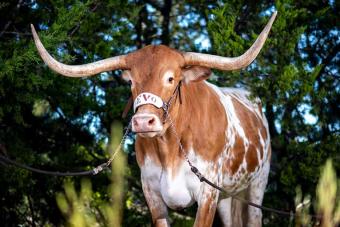
UT athletes were already known as Longhorns when, in 1916, a maverick longhorn steer was brought to campus on a train from South Texas and introduced at halftime to cheering football fans. The following month, the editor of the alumni magazine dubbed him Bevo, possibly by combining “beeve,” a plural form of “beef,” with “o,” a popular ending to nicknames at that time. Since then, UT has had more than a dozen Bevos, who are handled by the Silver Spurs student organization. UT’s costumed mascot is known as Hook ’Em.
Burnt Orange & White
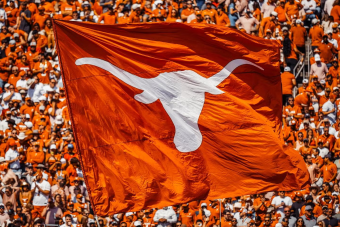
Orange and white were first used as UT colors in 1885, when two students on their way to a baseball game stopped at a general store to get ribbons for the crowd. The most plentiful colors in stock were orange and white. After experimenting with gold and white and even orange and maroon, UT officially adopted orange and white as its colors in 1900. Over the years, the shade vacillated between bright orange and burnt orange. Coach Darrell Royal revived burnt orange as the preferred shade for good in the early 1960s, abandoning bright orange for a hue that more closely matched that of a football.
Forty Acres
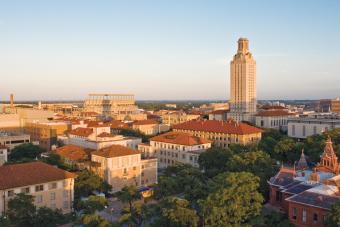
The Forty Acres is the nickname for the campus of The University of Texas at Austin because that was the size of the original tract set aside by the state. Those 40 acres formed a square that today is defined by 21st Street, Guadalupe Street, 24th Street and Speedway. A 40-acre square is a quarter of a mile along each side, so if you walk the perimeter of the original campus, you’ve walked a mile. Today, UT’s Main Campus is more than 430 acres.
Hook ’em Horns

Head cheerleader Harley Clark helped create the Hook ’em Horns hand symbol in 1955 by demonstrating it at a pep rally before the TCU game. He and roommate H.K. Pitts developed the sign the night before by experimenting with shadow puppets. Texas lost the game but gained a new tradition.
The Eyes of Texas
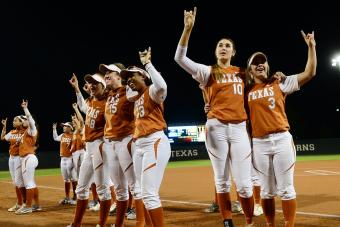
UT’s school song, “The Eyes of Texas,” was written and performed in 1903 by students, poking fun at a favorite saying of then-President William Prather. Read more about the history of "The Eyes of Texas". Today it is sung at the end of sporting events and university ceremonies. In the summer of 2020, President Jay Hartzell announced that UT will own, acknowledge and teach about all aspects of the origins of “The Eyes of Texas” as we continue to sing it moving forward with a redefined vision that unites our community. Read about those efforts.
The Eyes of Texas are upon you all the livelong day.
The Eyes of Texas are upon you, you cannot get away.
Do not think you can escape them at night or early in the morn.
The Eyes of Texas are upon you till Gabriel blows his horn.
Texas Fight!
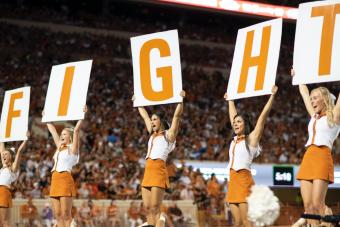
“Texas Fight!” was first performed at the 1923 football game vs. Texas A&M and quotes “The Eyes of Texas” after the yell section:
Texas Fight, Texas Fight, and it’s goodbye to A&M.
Texas Fight, Texas Fight, and we’ll put over one more win.
Texas Fight, Texas Fight, for it’s Texas that we love best.
(YELL) Give ’em hell! Give ’em hell! Go Horns go!
And it’s goodbye to all the rest!
(YELL)
Yea Orange! Yea White!
Yea Longhorns! Fight! Fight! Fight!
Texas Fight! Texas Fight! Yea Texas Fight!
Texas Fight! Texas Fight! Yea Texas Fight!
The Eyes of Texas are upon you,
All the livelong day.
The Eyes of Texas are upon you,
You cannot get away.
Texas Fight, Texas Fight,
For it’s Texas that we love best.
(YELL) Give ‘em hell! Give ’em hell! Go Horns go!
And it’s goodbye to all the rest!
Lighting the Tower
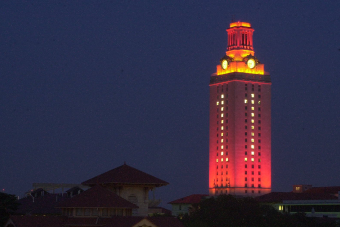
Since its opening in 1937, the UT Tower has been lit to celebrate the academic and athletic accomplishments of Longhorn students, faculty, staff and alumni, and to mark University milestones, illuminating the Tower on the Austin skyline. Numbers can be created by turning on certain lights in the building’s offices, including a 1 for national championships or the last two digits of a graduating class year. Learn what each lighting configuration symbolizes.
Gone to Texas
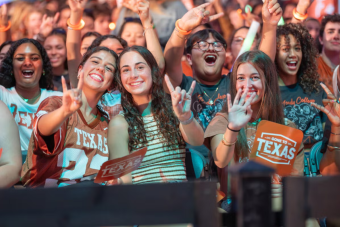
While the phrase "Gone to Texas" has a long history, at UT, it's used with pride by those accepted to The University of Texas at Austin, also known as “Texas.” On the eve of their first day of class, thousands of excited incoming students gather in front of the Tower for Gone To Texas, a huge celebration of all things UT that marks the official start of Longhorn life.
Big Bertha
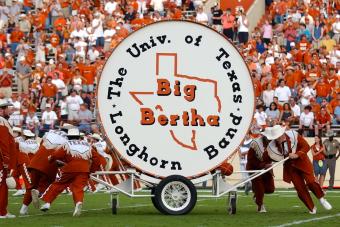
Among the many traditions of the Longhorn Band, also known as The Showband of the Southwest, is the world’s largest bass drum, Big Bertha. The original Big Bertha, pictured above, was retired after more than 60 years of playing a prominent ceremonial role in home football games. Big Bertha II debuted at the Texas-Iowa State game in 2022.
Good Luck Squirrels
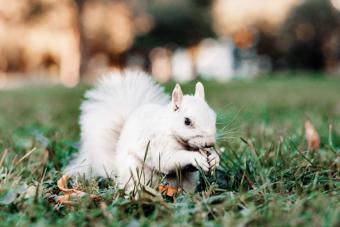
Tradition has it that any student who sees a white squirrel on the way to a test will get an A. The squirrels are not albinos but rather white fox squirrels with brown eyes, not pink.
Smokey the Cannon
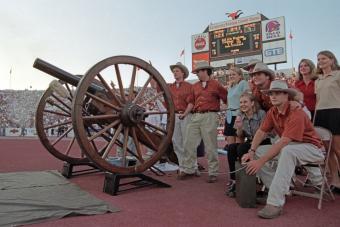
Smokey the Cannon was originally built by the University's mechanical engineering lab in 1953 in answer to the traditional gunshot blasts heard at Texas-Oklahoma football games. Operated by the Texas Cowboys student organization, the current cannon, Smokey III, is a fixture at every home football game and travels to select away games, including the Red River Rivalry.